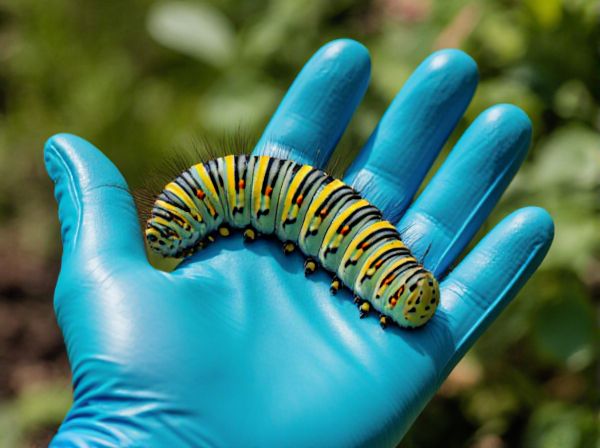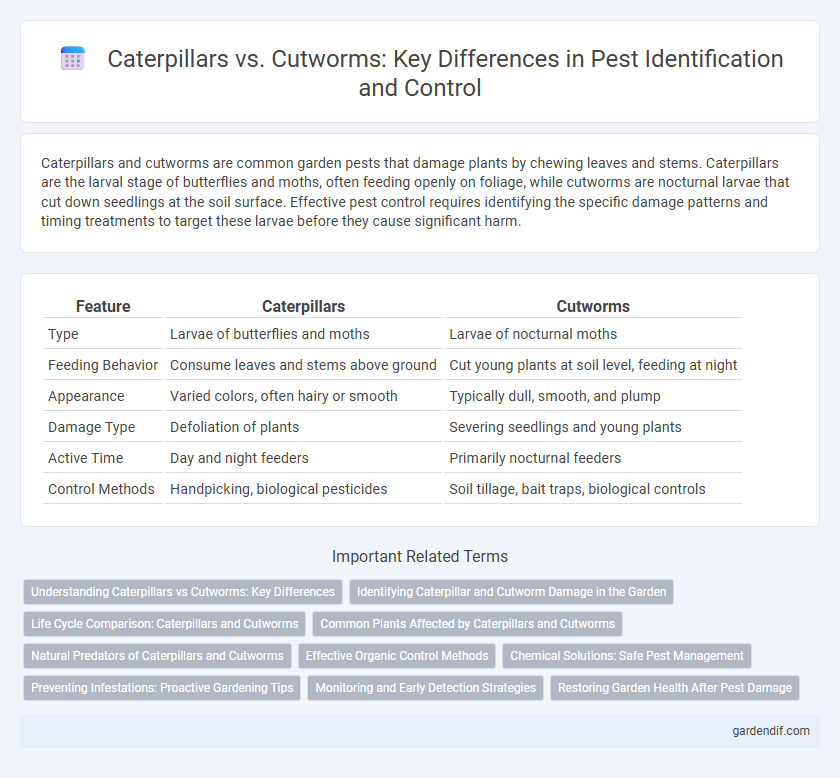
Caterpillars vs Cutworms Illustration
Caterpillars and cutworms are common garden pests that damage plants by chewing leaves and stems. Caterpillars are the larval stage of butterflies and moths, often feeding openly on foliage, while cutworms are nocturnal larvae that cut down seedlings at the soil surface. Effective pest control requires identifying the specific damage patterns and timing treatments to target these larvae before they cause significant harm.
Table of Comparison
| Feature | Caterpillars | Cutworms |
|---|---|---|
| Type | Larvae of butterflies and moths | Larvae of nocturnal moths |
| Feeding Behavior | Consume leaves and stems above ground | Cut young plants at soil level, feeding at night |
| Appearance | Varied colors, often hairy or smooth | Typically dull, smooth, and plump |
| Damage Type | Defoliation of plants | Severing seedlings and young plants |
| Active Time | Day and night feeders | Primarily nocturnal feeders |
| Control Methods | Handpicking, biological pesticides | Soil tillage, bait traps, biological controls |
Understanding Caterpillars vs Cutworms: Key Differences
Caterpillars and cutworms are both common garden pests that cause damage to plants, but they differ in behavior and appearance; caterpillars are typically active feeders on leaves, while cutworms primarily attack young stems at night by cutting plants off at the base. Cutworms are often nocturnal and hide in the soil during the day, whereas caterpillars are more visible and feed openly on foliage. Identifying these differences is crucial for effective pest management and targeted control strategies in agriculture and gardening.
Identifying Caterpillar and Cutworm Damage in the Garden
Caterpillar damage in the garden typically appears as irregular holes chewed on leaves, often along the edges or in the middle, while cutworm damage is characterized by young plants or seedlings cut off near the soil surface, often severed completely. Caterpillars are visible feeding on foliage during the day or night, whereas cutworms are nocturnal and hide in the soil during daylight. Identifying the specific feeding patterns and times can help distinguish between caterpillar leaf damage and cutworm stem damage for effective pest management.
Life Cycle Comparison: Caterpillars and Cutworms
Caterpillars typically undergo a complete metamorphosis with four distinct stages: egg, larva, pupa, and adult moth or butterfly, while cutworms mainly develop through a similar cycle but are known for their nocturnal larval stage that causes significant plant damage by cutting stems at ground level. Caterpillar larvae often feed openly on foliage, whereas cutworm larvae remain hidden in soil during the day, feeding primarily at night. Understanding the differences in their life cycles helps in timing pest control methods effectively for both species.
Common Plants Affected by Caterpillars and Cutworms
Caterpillars primarily damage leafy vegetables such as cabbage, lettuce, and spinach by chewing on leaves, while cutworms target the stems of young seedlings in crops like tomatoes, corn, and beans during nighttime feeding. Gardeners often notice caterpillar infestations on ornamental plants including roses and dahlias, whereas cutworms are notorious for cutting down seedlings at the soil surface across a wide range of vegetable gardens. Effective pest management requires understanding that caterpillars affect foliage visibly, while cutworms cause more concealed damage below the soil line, impacting plant survival in home gardens and commercial agriculture.
Natural Predators of Caterpillars and Cutworms
Natural predators of caterpillars include parasitic wasps, birds such as chickadees and warblers, and predatory beetles like ground beetles and ladybugs. Cutworms fall prey to soil-dwelling predators such as centipedes, spiders, and ground beetles, which help control their population in agricultural settings. Promoting biodiversity through cover crops and habitat conservation enhances the presence of these beneficial predators, reducing reliance on chemical pest control.
Effective Organic Control Methods
Caterpillars and cutworms cause significant damage to garden plants, but effective organic control methods can minimize their impact. Bacillus thuringiensis (Bt) targets caterpillar larvae without harming beneficial insects, while diatomaceous earth creates a physical barrier against cutworms. Introducing natural predators like parasitic wasps and encouraging birds also enhances pest control sustainably.
Chemical Solutions: Safe Pest Management
Chemical solutions for managing caterpillars and cutworms involve targeted insecticides such as Bacillus thuringiensis (Bt) and spinosad, which offer effective control with minimal environmental impact. Applying these bio-insecticides during early larval stages ensures maximum efficacy while preserving beneficial insects. Integrated pest management practices incorporating these safe chemical options reduce pest populations without risking resistance or harming non-target species.
Preventing Infestations: Proactive Gardening Tips
Caterpillar and cutworm infestations can be minimized by using row covers to protect young plants and regularly inspecting garden beds for early signs of larvae. Incorporating beneficial insects such as parasitic wasps and ladybugs helps control populations naturally by targeting eggs and larvae. Maintaining healthy soil through organic mulching and crop rotation reduces habitat suitability, disrupting the life cycles of these common garden pests.
Monitoring and Early Detection Strategies
Effective monitoring of caterpillars and cutworms involves regular field scouting and the use of pheromone traps to detect early infestations. Visual inspection of plant foliage for feeding damage and the presence of larvae helps identify pest activity before significant crop loss occurs. Implementing degree-day models assists in predicting pest emergence, optimizing timing for monitoring and early intervention strategies.
Restoring Garden Health After Pest Damage
Target affected plants immediately when restoring garden health after caterpillar and cutworm damage by pruning damaged leaves and stems to promote new growth. Apply organic insecticides such as neem oil or Bacillus thuringiensis (Bt) to control residual caterpillar and cutworm populations without harming beneficial insects. Enhance soil quality with compost and mulch to strengthen plant resilience against future pest infestations and improve overall garden ecosystem balance.
Caterpillars vs Cutworms Infographic

 gardendif.com
gardendif.com